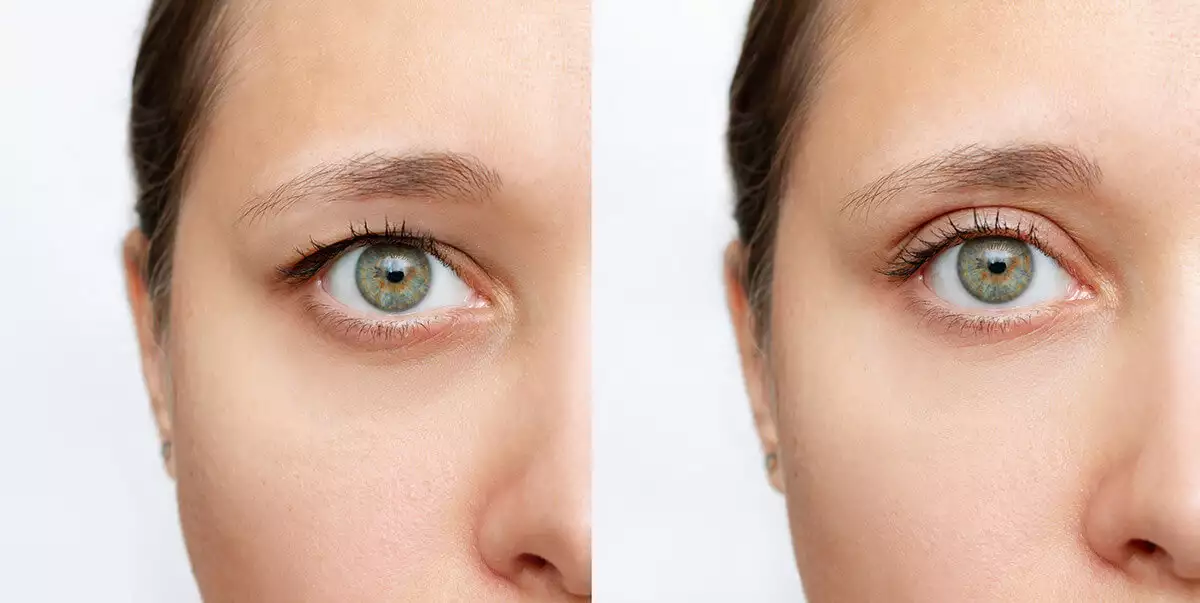
Blepharoplasty (Eyelid Lift) Surgery
What is Blepharoplasty surgery?
Blepharoplasty, also called an Eyelid Lift Surgery, is a Facial Aesthetic surgery that aims to improve the appearance of the eyelids by removing the excess skin and fat from the eyelids. Blepharoplasty involves the surgeon cutting into the creases of the eyelids to trim the sagging skin and remove the excess fat.
Why is Blepharoplasty performed?
Besides aging, severely sagging skin around the eyes can reduce peripheral vision, especially the upper and outer parts of the visual field. Blepharoplasty can reduce or get rid of any vision problems caused by excess skin. Additionally, Blepharoplasty gives the eyelids an aesthetically pleasant appearance that can make the patient look younger and more alert.
What are the conditions for Blepharoplasty surgery?
Blepharoplasty is recommended to patients that have:
- Excess skin obscuring the natural fold of the upper eyelids.
- Loose upper eyelid skin that impairs vision.
- Puffy upper eyelids that make the eyes look tired and sad.
- Bags and dark circles under the eyes.
The patient also needs to be able to safely undergo general anesthesia, and must not have medical conditions that can impair healing or would increase risk of surgery.
What are the Blepharoplasty surgery types?
There are two kinds of Blepharoplasty, they can be performed separately or at the same time.
- Upper Blepharoplasty involves removing excess fat, muscle, and skin from the upper eyelid, which alleviates the droopy, heavy, and hooded look of the eyes.
- Lower Blepharoplasty involves removing excess fat deposits, muscle, and skin from the lower eyelid, which alleviates wrinkles, dark circles, puffiness, and bags under the eyes. Also repositions and tightens the eyelid to create a well-contoured transition from the bottom eyelid to the midface.
What Are The Things To Be Considered Before Blepharoplasty?
Before Blepharoplasty, patients should:
- Avoid medication containing aspirin or ibuprofen (Advil, Motrin IB, others) for two weeks before the surgery. These medications may increase the risk of internal bleeding. Patients should confirm each medication and supplement they wish to take with their Patient Coordinator.
- Stop taking multivitamins 7 days prior to the surgery, and if it contains vitamin K should not be used for 30 days following the surgery.
- Stop taking oral contraceptives 30 days prior to the surgery.
- Refrain from smoking two weeks before the surgery. As nicotine and tobacco smoke delay healing and can result in scarring.
- Avoid sunburns for two weeks before surgery. Wear SPF 50 every day if possible.
- Not eat or drink anything, including water, after midnight the night before your surgery.
How is Blepharoplasty performed?
Blepharoplasty can be performed on the upper eyelids, lower eyelids, or both. Based on a preoperative evaluation of many factors, such as the patient’s underlying facial muscle structure, bone structure, and the symmetry of eyebrows, the Plastic Surgeon will decide how much skin, muscle, and fat to remove. The Plastic Surgeon will remove the puffiness and bags under the lower eyelids and the hooded skin on the upper eyelids, making the patient appear younger and healthier.
- Upper Blepharoplasty: During surgery, an incision is made in the upper eyelid crease. Also known as an upper eyelid lift, upper blepharoplasty helps patients look more rested, more alert, and younger.
- Lower Blepharoplasty: A lower blepharoplasty requires a small incision along the lower eyelids, either outside the lash line or inside each lid, to gain access to the area below each eye. Then excess tissue and fat deposits are removed or repositioned to rejuvenate and refresh the eye appearance.
Any scars from Blepharoplasty will be hidden in the natural eyelid creases, making them almost invisible.
What are The Things To Be Considered After Blepharoplasty Surgery?
After the surgery, the patient should:
- Avoid straining, heavy lifting, swimming, and strenuous activities, such as aerobics and jogging, for ten to fourteen days. Specifically, the patient should avoid activities in which they must move their head abruptly or that increase the blood pressure in their head. This restriction includes, but is not limited to, bending over, which causes your head to be lower than your heart, and lifting objects heavy enough to cause you to strain. This restriction may apply for three to four weeks.
- Take frequent naps and avoid activities that may dry the eyes, including reading, watching television, wearing contacts, and using a computer.
The patient may experience excessive tearing, light sensitivity, and double vision just after the surgery. The incisions will be red and visible at first, and the eyelids may be puffy and feel numb for several days. Swelling and bruising, similar to having "black eyes," will likely last a week or more.
The Plastic Surgeon will remove the stitches between two and seven days after the eyelid surgery. The patient may feel well enough to resume normal activities around the tenth day of recovery.
What Are The Risks of Blepharoplasty?
Eyelid surgery can occasionally result in
- Temporary blurry or double vision
- Asymmetrical eyes
- Hematoma
- Noticeable scarring
- Excessive bleeding
- Developing a blood clot in a vein
- Infection
- An allergic reaction to the anesthetic
Rarely, Blepharoplasty can result in serious problems
- Eye muscles injuries
- The lower eyelid drooping away from the eye and turning outwards
- Eyelid retraction
- Visual impairment
Visual impairment is extremely rare and vision, usually, improves in the long term.
